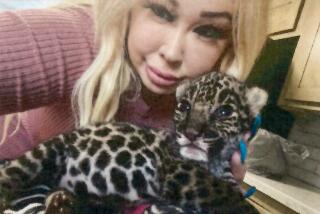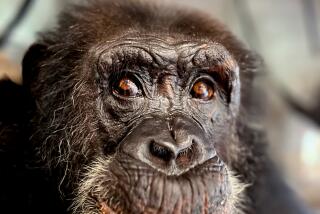Rescued Jungle Animals Receive Haven in Brazil ‘Halfway House’ : Wildlife: Noah’s Park helps Amazon creatures readjust to the wild. Most of them have been seized at street markets by federal agents.
MANAUS, Brazil — A crackdown on the lucrative illegal trade in jungle animals has created a new problem: what to do with those rescued. Noah’s Park may be the solution.
Returning directly to the rain forest is difficult for animals accustomed to cages. Many starve or are killed by predators.
Noah’s Park, an experimental “halfway house” in the western Amazon, helps animals readapt to the wild.
It also fosters the breeding of animals threatened by the destruction of the rain forest. Ranchers and farmers have razed about 10% of the 2 million square miles of Amazon wilderness.
“This is a completely new concept for dealing with a lot of species at once,” said Dr. Marc van Roosmalen, a Dutch primatologist in charge of the project.
Noah’s Park takes in nearly all animals native to the Amazon. Jaguars and pumas are excluded because they might prey on the others.
Since it opened in February, 1990, Noah’s Park has received more than 200 monkeys, macaws, parrots, toucans, capybaras, coatis, tapirs, peccaries, sloths, boas, turtles, and even a rare giant otter.
Most are seized at street markets by federal agents of the Brazilian Environment Institute. Others are taken from tourists who buy animals as mementos--boa constrictors are a favorite--often without knowing that it is illegal to hunt, keep or sell wildlife in Brazil.
They are delivered to Van Roosmalen, who treats the sick ones and observes all the animals for up to six weeks, until he feels they are ready for the park.
“Normally, they’re traumatized, very afraid of people and guns,” he said. “The first problem we have is to give them back confidence in humans.”
A chain across a rutted, sandy road marks the entrance to Noah’s Park, a 70,000-acre expanse of rain forest on the outskirts of Manaus, 3,000 miles northwest of Rio de Janeiro.
In a clearing, brilliant scarlet macaws screech a greeting. A purple-feathered trumpeter wanders up, its coo sounding unnervingly like a video arcade game.
“Look, there’s a hyacinth macaw,” said Rejane Neves, who quit her job as a bank manager to join the project. “It would fetch $4,000 in the United States or Europe.”
Wildlife experts estimate that fewer than 5,000 hyacinth macaws remain on the planet.
Neves said the species is not native to the Amazon, but to the Pantanal wetlands of western Brazil. Park officials freed this one, she said, only when they were sure it would not leave the area.
At midday, park worker Cosmo da Silva dumped a pail of cutup oranges, bananas and pineapples onto a log platform in the forest. The branches of trees 130 feet high began to thrash and sway, and a gallery of monkeys dropped in for lunch.
Among more than 100 monkeys in the park are capuchins, sakis, tamarins and uakaris. They live in generally peaceful proximity that would be unthinkable in the wild.
Many are totally at ease with humans. They hop onto the shoulders of visitors, nuzzle their ears and crawl inside shirts. Monkeys are master pickpockets, and any loose object is fair game.
A young squirrel monkey jumped onto the platform holding a roll of film. A photographer grabbed for his camera bag--too late. Da Silva coaxed the monkey over and snatched the film back, to screams of protest from the thief.
Nearby, a male woolly monkey carried a baby squirrel monkey on its back. The older monkey had adopted the motherless infant, one of many at the park.
“Almost the only way to get a monkey is to shoot the mother and take the baby,” Van Roosmalen said. “Most of our monkeys here are babies.”
A wild monkey learns survival techniques on its mother’s back, including what flowers and fruits to eat, the primatologist explained. Orphans must learn from groups of other monkeys.
“The Manaus forest is very low-productive,” Van Roosmalen said. “A group of monkeys needs 1,000 hectares (2,500 acres), and spider monkeys need 2,000 hectares. They only can survive if they know the forest well.”
Peccaries, a jaguarundi and the rare giant otter, called Ottie, live in separate enclosed areas.
Visitors enter Ottie’s double-doored, covered pen cautiously, aware that giant otters have been known to attack and kill humans. The seal-sized otter barks and lunges aggressively at fish tossed from a pail, but Da Silva insists that there is no danger.
“He’s been alone too long and needs a female,” he said.
Ottie cannot return to the wild because he never learned how to fish and now is too old to do so. If freed, he probably would go after a farmer’s chickens and be shot or captured.
Some monkeys have been crazed by torture or too much time alone in cages.
“Imagine what would happen if a human child were kept that way,” Van Roosmalen said. “Monkeys are no different. We’re all primates.”
He wants to put those animals on a separate river island. “We can give them a nice life,” Van Roosmalen said, “but they’ll never be normal again.” Another goal of the park is to breed endangered animals, especially monkeys.
“All large monkeys are endangered, not because of hunting but because of habitat loss,” said Van Roosmalen, who has studied primates in the rain forests of neighboring Suriname and French Guiana. “If they breed well, we can reintroduce them in their native habitat.”
The park was started by the Vitoria Amazonica Foundation, a nonprofit society licensed by the Brazilian Environment Institute. Among its supporters is Conservation International of Washington, D.C., which provided a grant of $25,000.
Silvio Barros, president of the foundation, wants to use the park to educate Brazilians and foreigners about the rain forest. He envisions a tourist attraction with elevated walkways, museum, arboretum, snake house and amphitheater.
“You can’t love what you don’t know,” Barros said. “We think ecotourism is the best way to make foreigners pay for the preservation of the Amazon.”
Van Roosmalen prefers to keep the park devoted to scientific research and has protested the foundation’s plans.
“They want to make a Disneyland out of the park,” he said. “I want it completely natural.”
He and the government said a plan was being approved for him to create a new foundation to run the park and invite U.S. primatologist Tom Defler, who works in Colombia, to join the project.
“The (Amazonica) foundation underestimated what we’re doing,” Van Roosmalen said. “Now I will be able to do what is scientifically correct.”
More to Read
Sign up for Essential California
The most important California stories and recommendations in your inbox every morning.
You may occasionally receive promotional content from the Los Angeles Times.










